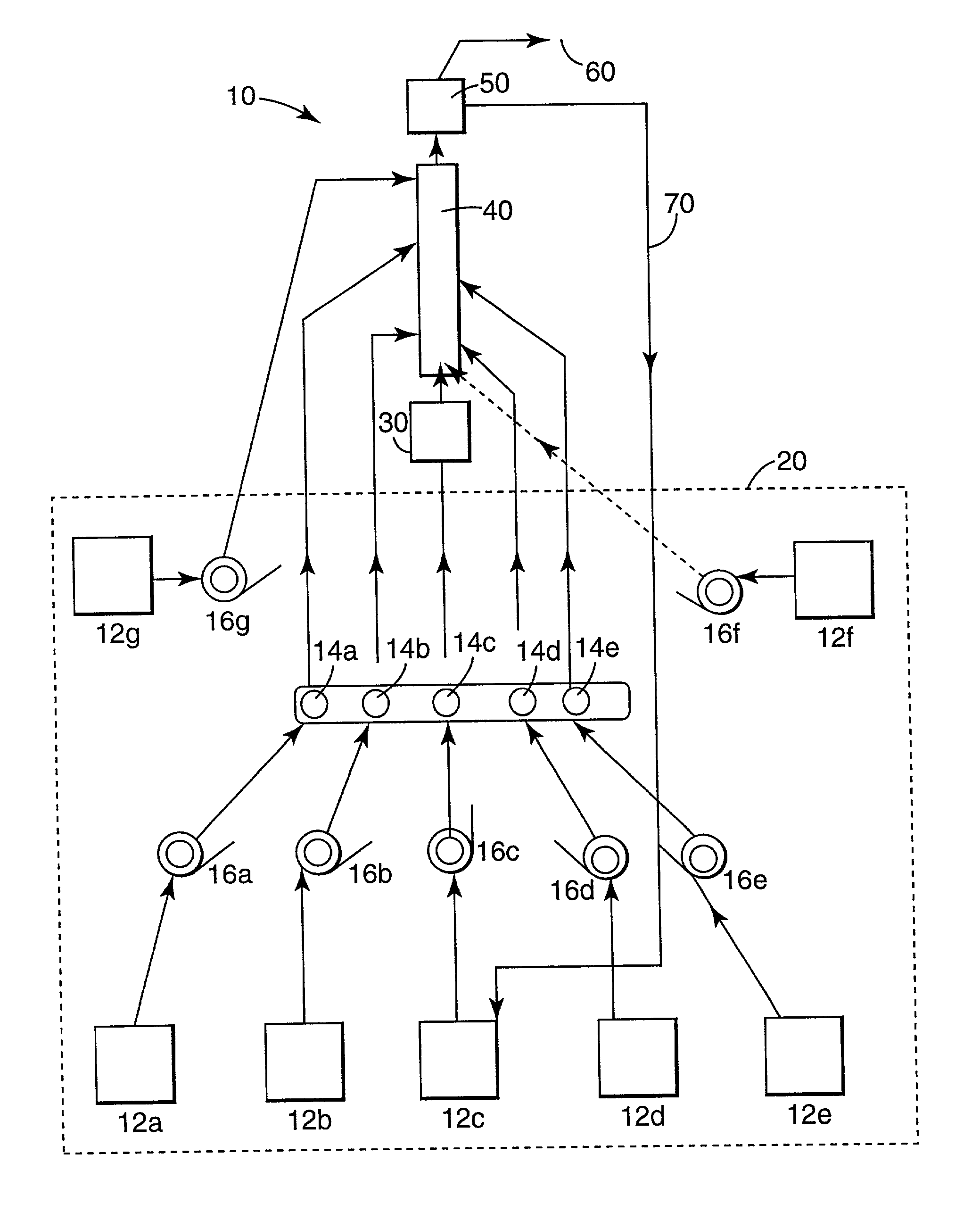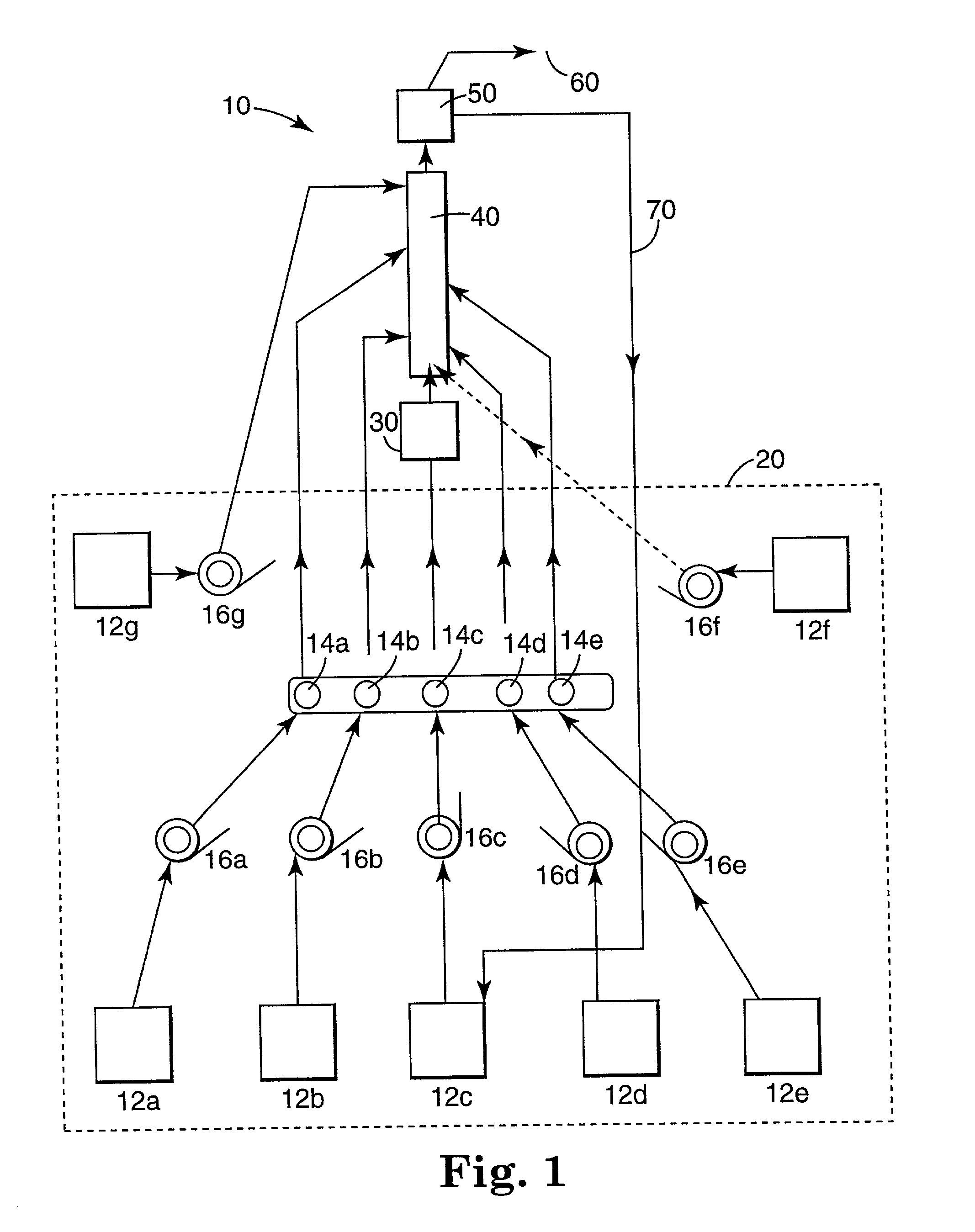Continuous process for the production of combinatorial libraries of materials
a technology of combinatorial libraries and continuous process, applied in chemical/physical/physical-chemical stationary reactors, liquid-gas reaction processes, chemical/physical processes, etc., can solve the problems of affecting the efficiency of the production process, and affecting the effect of the production process
- Summary
- Abstract
- Description
- Claims
- Application Information
AI Technical Summary
Problems solved by technology
Method used
Image
Examples
example 1
Poly(isoprene-4-vinyl pyridine) block copolymer--10 L STR
[0122] This example illustrates that the composition of constituent blocks in a block copolymer, made from anionically polymerizable monomers can be varied with time in the continuous process. This concept can be used to generate large material libraries.
[0123] An initiator slurry was prepared by mixing 1267 ml of 1.3 M sec-butyl lithium in cyclohexane with 4094 g of oxygen-free toluene and stirred at room temperature for about 30 minutes. Purified isoprene monomer (pressure fed at a rate of 85.8 g / min), purified THF (pressure fed at a rate of 23 g / min) and purified toluene solvent (diaphragm-pumped at a rate of 123.8 g / min) were fed into zone 1 of the STR. The initiator slurry was introduced by peristaltic pump at a rate of 12.5 ml / min into zone 1 of the STR. A color change from clear to yellow was observed in zone 1 when the initiator solution contacted the monomer, and an exotherm resulted. The reaction temperature was kept...
example 2
Poly(styrene-4-vinyl pyridine) block copolymer--2L Glass STR
[0126] This experiment exemplifies that this invention can be extended to different size STRs. An initiator slurry was prepared by mixing 585 ml of 1.3 M sec-butyl lithium solution in 6049 g of O.sub.2-free toluene and continuously stirring at room temperature for about 30 minutes. The stirring was done under nitrogen to prevent stratification and oxygen contamination. Purified styrene monomer (pressure fed at a rate of 31.7 g / min) and purified toluene solvent (diaphragm-pumped at a rate of 154.9 g / min) were passed into zone 1 of the STR. The initiator slurry was introduced by peristaltic pump at a rate of 19.6 ml / min into zone 1 of the STR. The solids loading of this reaction was 44 wt % in styrene monomer. A color change, from clear to red-orange, was observed in zone 1 when the initiator solution contacted the monomer, and an exotherm resulted. The mixture temperature in zone 1 was kept at about 43.degree. C. by adjustin...
example 3
Poly(styrene-4-vinyl pyridine) block copolymer--2L Glass STR
[0129] This experiment exemplifies that by not allowing the reactor to achieve steady state after a process change unexpected midpoints between anticipated or selected library members can be obtained.
[0130] An initiator slurry was prepared by mixing 585 ml of 1.3 M sec-butyl lithium solution in 6049 g of O.sub.2-free toluene and continuously stirring at room temperature for about 30 minutes. The stirring was done under nitrogen to prevent stratification and oxygen contamination. Purified styrene monomer (fed by a reciprocating piston-pump at a rate of 31.7 g / min) and purified toluene solvent (fed by a reciprocating piston-pump at a rate of 154.9 g / min) were passed into zone 1 of the STR. The initiator slurry was introduced by peristaltic pump at a rate of 19.6 ml / min into zone 1 of the STR. The solids loading of this reaction was 44 wt % in styrene monomer. A color change, from clear to red-orange, was observed in zone 1 wh...
PUM
| Property | Measurement | Unit |
|---|---|---|
| temperatures | aaaaa | aaaaa |
| temperature | aaaaa | aaaaa |
| volume | aaaaa | aaaaa |
Abstract
Description
Claims
Application Information
 Login to View More
Login to View More - R&D
- Intellectual Property
- Life Sciences
- Materials
- Tech Scout
- Unparalleled Data Quality
- Higher Quality Content
- 60% Fewer Hallucinations
Browse by: Latest US Patents, China's latest patents, Technical Efficacy Thesaurus, Application Domain, Technology Topic, Popular Technical Reports.
© 2025 PatSnap. All rights reserved.Legal|Privacy policy|Modern Slavery Act Transparency Statement|Sitemap|About US| Contact US: help@patsnap.com


